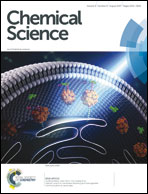Multi-target-directed phenol–triazole ligands as therapeutic agents for Alzheimer's disease†
Abstract
Alzheimer's disease (AD) is a multifactorial disease that is characterized by the formation of intracellular neurofibrillary tangles and extracellular amyloid-β (Aβ) plaque deposits. Increased oxidative stress, metal ion dysregulation, and the formation of toxic Aβ peptide oligomers are all considered to contribute to the etiology of AD. In this work we have developed a series of ligands that are multi-target-directed in order to address several disease properties. 2-(1-(3-Hydroxypropyl)-1H-1,2,3-triazol-4-yl)phenol (POH), 2-(1-(2-morpholinoethyl)-1H-1,2,3-triazol-4-yl)phenol (PMorph), and 2-(1-(2-thiomorpholinoethyl)-1H-1,2,3-triazol-4-yl)phenol (PTMorph) have been synthesized and screened for their antioxidant capacity, Cu-binding affinity, interaction with the Aβ peptide and modulation of Aβ peptide aggregation, and the ability to limit Aβ1–42-induced neurotoxicity in human neuronal culture. The synthetic protocol and structural variance incorporated via click chemistry, highlights the influence of R-group modification on ligand-Aβ interactions and neuroprotective effects. Overall, this study demonstrates that the phenol–triazole ligand scaffold can target multiple factors associated with AD, thus warranting further therapeutic development.



 Please wait while we load your content...
Please wait while we load your content...